ROBEX – Robotic Exploration of Extreme Environments
Table of contents
Project data
| Titel | Title ROBEX – Robotische Exploration unter Extrembedingungen | Robotic Exploration of Extreme Environments Förderer | Funding Helmholtz-Gemeinschaft |
Report in the year book 2017
IN ICY DEPTHS – CONCRETE FOR MARINE RESEARCH

3D print of a self-erecting construction for a moon base made of modular elements, photographed during the demo-mission in summer 2017 on Mount Etna
At the end of 2017, the Helmholtz Alliance ROBEX – Robotic Exploration of Extreme Environments (www.robex-allianz.de) was completed after five successful years. At our institute, two very different subprojects were investigated within the project – possibilities for building on the moon and concrete pressure housings made of ultra-high performance concrete (UHPC) for the deep sea. The goal here was to supply with long-lasting energy sources various applications of deep-sea research, such as autonomous underwater vehicles in hard-to-reach areas.
UHPC is very well suited for waterproof structures due to its graded aggregate size distribution, the use of finely ground cement and the addition of micro-silica as filler. In addition to the high density of the material, UHPC is characterized by a very high compressive strength of up to 250 MPa compared to normal strength concrete. Within the project, different housing shapes and sealing systems have been developed, manufactured and tested. In addition to a large number of short-term pressure tests in the pressure tank of the German Research Institute for Artificial Intelligence (DFKI) in Bremen, two long-term experiments in the Arctic Ocean at 2,500 m depth at -1 °C were completed (2015/16 and 2016/17). It could be shown that the housings made of UHPC are watertight even after one year stay deep in the sea without additional coating. Numerous numerical simulations using the multiPlas nonlinear material law in ANSYS have enabled parameter design studies to be performed and compared with experimentally determined data. For example, the influence of a multi-axial load on UHPC cubes with 10 cm edge length was determined in a triaxial testing machine and considered in the calculation. Based on the results obtained, design guidelines could be derived. At the present state of knowledge, the practicable application field for cylindrical concrete pressure housings is up to 3,000 to 3,800 m.
In the subproject ‘building on the Moon,’ modular structures have been developed and studied which can be manufactured and assembled on the ground and erected without lifting technology. Such a base could be used in the future as a research and protection structure or as a starting point for the exploration of other planets such as Mars. The goal is to manufacture the concrete for the needed individual segments using the type of resources available on the moon.
Report in the year book 2016
Turned up – concrete in the deep sea
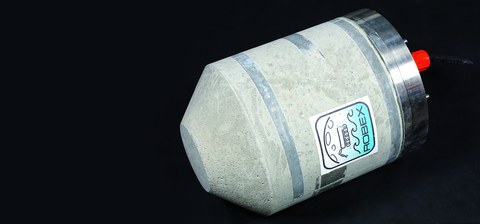
Concrete pressure housing after one year at the Arctic Sea in 2,500 m depth
Within the Helmholtz Alliance ROBEX – Robotic Exploration of Extreme Environments (www.robex-allianz.de), the Institute of Concrete Structures is working on two subprojects which could not be more different: the development of concrete pressure housings for deep-sea environments and the investigation of methods for building on the moon.
Ultra-high performance concrete (UHPC) with compressive strengths up to approx.
250 N/mm², which is approximately eight times that of normal strength concrete is an ideal material for use in the deep sea. The precisely determined gradient of grain size distribution of the aggregates, the finely ground cement and the addition of micro silica as filler leads to a very dense structure. The UHPC has a much smaller pore volume compared to that of normal strength concrete, making the material waterproof or even airtight. In addition to optimizing the form of pressure housings under hydrostatic load, this research focuses on the design of the housing by taking advantage of the increased compressive strength of the concrete under multiaxial stress.
Recently, the long-term stability of the structure was proven by short-term pressure tests in the pressure tank of the German Research Institute for Artificial Intelligence (DFKI) in Bremen. In July 2016, a concrete pressure housing was recovered after one year in the Arctic Ocean at a depth of 2,500 m. For over a year, the creep behaviour under biaxial stress on the inner surface and the development of humidity and temperature in the interior of the housing were recorded. Without any additional coating, the 25 mm thinn UHPC wall of the housing withstood a water pressure of 250 bars without any problems.
In the subproject ‘building on the moon,’ modular structures were developed and examined, which can be mounted on the ground and erected without lifting technology. A moon base constructed in this manner could be used as a research station, as a protective shelter, or as a starting point for the exploration of other planets, such as Mars. The goal is to manufacture the concrete for the single segments utilizing resources found on the moon. As a potential manufacturing process, two methods are currently being investigated: production with the help of steam pressure and 3D printing with concrete.
Report in the year book 2015
Abgetaucht – Beton in der Tiefsee
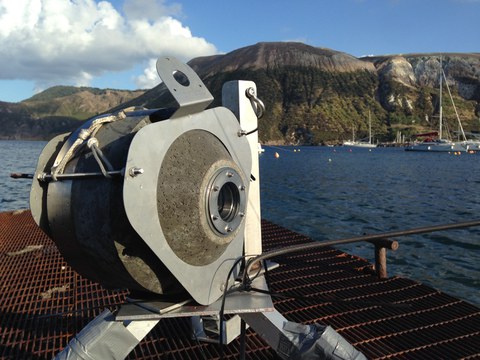
Test of camera housing made from UHPC near the island Vulcano (Italy)
As part of the Helmholtz Alliance ROBEX – Robotic Exploration of Extreme Environments (www.robex-allianz.de), concrete pressure housings for use in deep sea have been developed at our institute. The deep-sea research is an essential part of the marine research. Not only ecological aspects, but also increasingly economic interests such as the search for alternative energy resources (e.g. methane) are playing a significant role. So far, mainly expensive materials, such as titanium and aluminium, are used for the construction of temporary and permanent research stations underwater due to the extremely corrosive environment. The production of metal housings is usually done through CNC milling, which is costly and the manufactured housing size is limited by the available machine.
Ultra-high performance concrete (UHPC) allows uniaxial compressive strengths up to 250 N/mm², what is approximately eight times higher than conventional normal concrete. The basic difference to normal concrete can be found in the material’s composition. Solid materials such as quartz, basalt, bauxite or corundum are used as aggregate. The use of a precisely matched particle size distribution of aggregates as well as a finely ground cement and the addition of micro silica as a filler result in a highly dense material. In contrast to normal concrete, the multiple smaller pore space of UHPC makes the material waterproof up to a gas-tight level.
In addition to the shape optimization under hydrostatic load, the research focus is on the design of housings, taking into account the increased compressive strength of concrete under multiaxial load. The material parameters for the calibration of non-linear concrete models are determined for numerical simulation in multiaxial compression tests. The UHPC housings are tested in the pressure chamber of the German Research Institute for Artificial Intelligence (DFKI) in Bremen until implosion of the specimen to determine the short-term behaviour of the material. With the help of the Alfred Wegener Institute (AWI), a pressure housing was placed at a depth of 2,500 m in July 2015 during a Polarstern expedition in the arctic sea to study the durability and creep of UHPC under high hydrostatic pressure. The housing will remain there for one year.
Thanks to the WPE company for supporting the project.
Report in the year book 2014
ROBEX − Two worlds come together
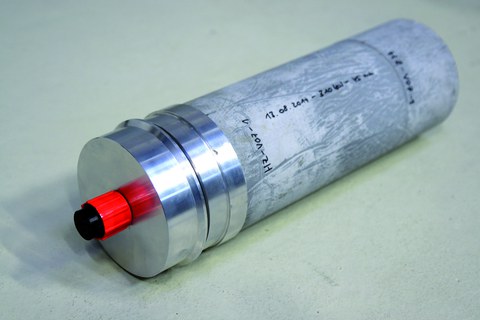
Prototype of a deep sea pressure housing made of UHPC
This year, the University of Würzburg and Airbus could be counted as two new partners among the 14 previous partners of the Helmholtz Alliance ROBEX (Robotic Exploration under extreme conditions). The basic idea of the Alliance is the connection of the research areas space and deep sea to identify common challenges in fields such as navigation, power transmission or collection of measurement data in extreme environments. The focus is on the pooling of resources and the joint development of new technologies for application areas in the deep sea and on the Earth‘s moon.
The research focus of our institute is the development of new application fields for concrete. In addition to studying the applicability of ultra-high performance concrete (UHPC) in the deep sea, the development of a concrete, consisting mainly of lunar resources and manufactured under lunar conditions is part of the project. By using the dry-mix/steam-injection-method, a dry mixture consisting of aggregate and cement hardens in a sample form under steam pressure. Initial experiments have shown that after a short time of steam exposure – and thus with little use of water – a relatively good strength can be achieved. The objective of this material development is the establishment of a permanent moon base that could be used as a research station, as a protective structure or as a base for exploring other planets.
In the field of deep-sea research, the first pressure housing could be completed from UHPC and tested in the pressure chamber of the GEOMAR in Kiel after only one year of development. So far, mainly expensive materials such as titanium and aluminium are used due to the extremely corrosive marine environment. An inexpensive alternative made of UHPC could help to build bigger temporary and permanent research networks. The design of the concrete housings was made for 3000 m and 5000 m water depth and the calculated load could be achieved without implosion. The fulfilment of the requirements for sealing and resealing could be demonstrated. The material used was kindly provided by the company WPE (Rheinsberg). Further studies, on the long-term behaviour, as well as in alternative sealing concepts are being planned.
Report in the year book 2013
Research under Extreme Conditions
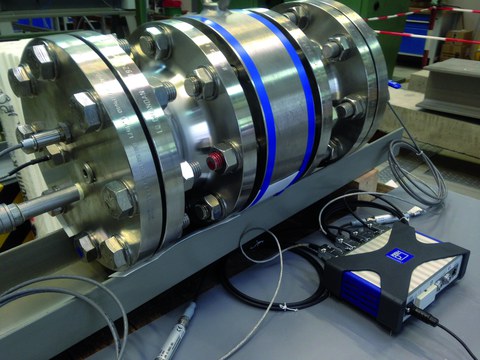
Concrete production facility for steam injection under pressure.
The Helmholtz Alliance „ROBEX“ (robotic exploration under extreme conditions) is a collaborative research project in which 15 institutions throughout Germany are involved. For the first time, the research fields deep sea and space, both dealing with extreme environmental conditions, are linked in an alliance. The focus is on the joint development of technologies for the exploration of hard to reach areas such as deep-sea trenches and the Earth‘s moon − the two main research areas − but also the polar regions or other celestial bodies.
Our institute is a competent partner on both sides. With many years of experience in the field of high-performance concrete, we work in two sub-projects with various project partners. In space, there is the scientific challenge to develop a concrete which consists largely of materials of the lunar surface and is manufactured under lunar conditions. The newly developed material and a corresponding suitable production method might find an application in the future establishment of a permanent lunar base, which could be used as a research station, a protection construction or as a base for exploring other planets, such as Mars. To minimize the water demand in concrete, we currently work on a steam-pressure process which can later be used for the production of prefabricated parts.
In deep-sea research not only environmental aspects, but also increasingly economic interests such as the search for alternative energy resources e.g. in the form of methane play an important role. So far, mainly expensive materials such as titanium and aluminum are used for the construction of temporary and permanent research stations under water or even for pressure vessels for measuring instruments due to the extremely corrosive environment. Therefore, the suitability of high-strength concrete for underwater pressure vessels is examined in our second ROBEX sub-project along with the Jacobs University Bremen to provide a low cost alternative to titanium containers which are currently in use. In this case, it is necessary to find a suitable concrete composition and a corresponding reinforcement. Furthermore, the effects of the marine environment such as high pressure and, as regards corrosion, a high concentration of chlorides and sulphates have to be investigated.
Report in the year book 2012
Building on the moon – only dreams of the future?
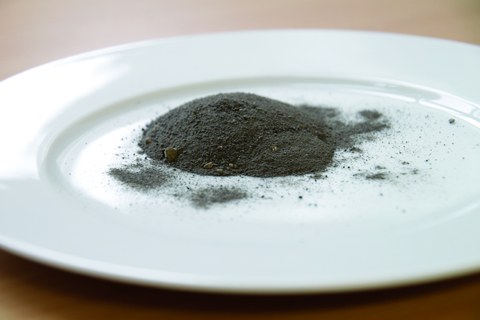
Regolith substitute
The ROBEX-project (Robotic Exploration of Extreme Environments) is a Helmholtz Alliance consisting of the Alfred Wegener Institute for Polar and Marine Research (AWI), the German Aerospace Centre (DLR), the Helmholtz Centre for Ocean Research Kiel (GEOMAR), the MARUM University Bremen, the Jacobs University Bremen, the German Research Centre for Artificial Intelligence (DFKI) as well as the Technical Universities Munich, Kaiserslautern, Berlin and Dresden. It is the aim of the project to connect two up to now separate research fields which both deal with extreme environments: the deep sea and the moon. As a result there should evolve an overarching alliance for identification of common technologies, focusing on the development of mobile and modular constructions as for example central docking stations or intelligent autonomous control.
Our institute is a competent partner of the alliance with wide experiences in the field of high-performance concretes. Part of the project is the development of a construction material from (mainly) lunar resources. A feasible lunar base could be used in the future as research facility, as shielding construction or as starting point for the exploration of other planets, like the Mars.
The lunar environmental conditions as vacuum, high solar and cosmic radiation, reduced gravity and extreme differences in temperature from -230 to +120° C are a major challenge for material and construction. A sustainable and structure optimised construction stands in the foreground besides the environmental influence. The area of responsibility ranges from the investigation of the material properties through development of a production process to the design of a modular building structure.
Early approaches of creating a lunar concrete haven’t been successful because of the week points in each process. The issue of existing water on the moon plays an important role in the development and couldn’t have been answered yet. The way of building a lunar base seems endless, also today. We want to contribute with our work to answer a part of the open questions.
